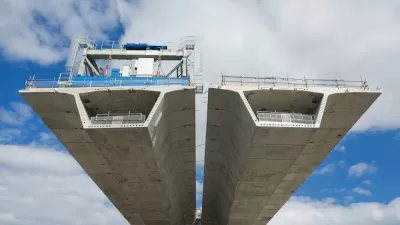A new analysis form the Pew Charitable Trusts showed a 20 percent reduction in state spending on transportation between 2002 and 2011, compared to a 4 percent drop from the federal government over the same period.
As written in Governing by Daniel Vock, a recent analysis on transportation funding throughout the last decade by the Pew Charitable Trusts illuminated the shifts in federal and state spending. While federal funding usually receives the brunt of criticism as an unreliable partner for funding, in fact, states are also to blame in their drop of transportation spending over the last decade.
As the report discusses, between 2007 and 2011, "average annual spending on highway and transit nationwide was $207 billion. Of that total, $82 billion, or 40 percent, came from states; $74 billion, or 36 percent, from localities; and $51 billion, or 25 percent, from the federal government."
According to the Vock, the federal government's average spending figures "are higher in part because it was still spending some $13 billion in stimulus money on transportation in 2011. Without the money from the recovery package, federal spending would have dropped by 25 percent between 2002 and 2011. The biggest reason for the spending drop at both levels was a decrease in buying power from fuel taxes."
The federal government relies on this fuel tax for maintaining and funding most of the country's transportation infrastructure, but expenditures have been outpacing revenues for the last decade. As Vock writes, "states are only in a slightly better position. They rely on vehicle taxes for a fifth of their road funding, but those revenues, too, have been falling. Pew suggested that declining vehicle ownership may be one reason those taxes dropped by $8 billion, or 21 percent, in the decade leading up to 2012."
Coupled with the decline in fuel tax revenues, "the cost of road construction increased by 60 percent between 2002 and 2012, meaning the dollars states and the federal government collected did not stretch as far."
FULL STORY: States Are Actually Driving Transportation Funding Declines

Study: Maui’s Plan to Convert Vacation Rentals to Long-Term Housing Could Cause Nearly $1 Billion Economic Loss
The plan would reduce visitor accommodation by 25,% resulting in 1,900 jobs lost.

North Texas Transit Leaders Tout Benefits of TOD for Growing Region
At a summit focused on transit-oriented development, policymakers discussed how North Texas’ expanded light rail system can serve as a tool for economic growth.

Why Should We Subsidize Public Transportation?
Many public transit agencies face financial stress due to rising costs, declining fare revenue, and declining subsidies. Transit advocates must provide a strong business case for increasing public transit funding.

A Visual Celebration of Manhattan’s Chinatown Elder Community, Through Food
Lanterns, cafeteria trays, and community connection take center stage in this stunning photo essay.

How to Make US Trains Faster
Changes to boarding platforms and a switch to electric trains could improve U.S. passenger rail service without the added cost of high-speed rail.

Columbia’s Revitalized ‘Loop’ Is a Hub for Local Entrepreneurs
A focus on small businesses is helping a commercial corridor in Columbia, Missouri thrive.
Urban Design for Planners 1: Software Tools
This six-course series explores essential urban design concepts using open source software and equips planners with the tools they need to participate fully in the urban design process.
Planning for Universal Design
Learn the tools for implementing Universal Design in planning regulations.
City of Santa Clarita
Ascent Environmental
Institute for Housing and Urban Development Studies (IHS)
City of Grandview
Harvard GSD Executive Education
Toledo-Lucas County Plan Commissions
Salt Lake City
NYU Wagner Graduate School of Public Service




























